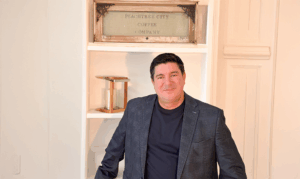The mural located behind the dais in Tyrone’s Town Hall has recently been the topic of much debate as to whether or not the image it presents is appropriate. This is both for the historical representation and the location behind the center of town business and civic engagement.
I attended the meeting where concerns were raised about the mural – specifically that the image represented a one-sided perspective of history, and surely do not reflect Tyrone of today and where the town hopes to be in the future, unless Tyrone hopes to return to slavery of its residents.
A request was made for the council and mayor to consider modifying the mural to make it more representative of today and the future. Afterwards, to the surprise of many, the Town Council had decided to temporarily cover the mural as it considered how to best move forward.
Tyrone’s mayor, Eric Dial, authored an excellent letter to the editor, outlining his personal views while also making a plea for civil discussion and debate regarding the future of the mural. I was particularly struck by Mayor Dial’s call for a citizens’ panel to determine the fate of the mural that he stated belonged to the community, as does the Town Hall.
There was another town meeting to hear public feedback regarding the mural. After spirited public commentary, both for and against the mural, the council voted to retain the mural as is.
It is my sincere hope that Mayor Dial and council do not consider this to be the end of the story, but yet another interim step. During the meeting several speakers decried any efforts to erase history – something I personally agree with.
However, several other speakers pointed out that the mural as depicted does not provide an accurate representation of that history, something I also agree with.
If there is going to be a mural depicting an accurate historical representation of that period behind the dais in the publicly owned Town Hall, every effort should be made to insure that it represents the whole historical story.
Some have shared their opinions that the mural is not offensive, with at least a few going so far as to perceive the mural as a diverse representation of history. I submit that this is a very myopic viewpoint and suggest that Mayor Dial’s opinion is much more accurate – some indeed genuinely view the depiction as an offensive representation of history.
I have no doubt that during the period there must have been at least some black revolutionaries present in Tyrone. If there were slaves, perhaps currently represented as indistinguishable figures picking cotton in the background, they should be more accurately represented.
That would include one or more of them that had been whipped or hobbled for trying to escape or worst yet, daring to learn to read and write. That would include an overseer minding the slaves, complete with whip or rifle in hand to insure they obeyed their master.
In the current depiction there is a raccoon in one of the trees. For accuracy, perhaps it would be best to adorn one of the trees with a lynched slave. Maybe there was at least one freed black present in Tyrone during that period that could be reflected somewhere in the mural. The American Indian that is depicted being paid for trading his crops is surely an anomaly, as this was long after the trail of tears where Georgia’s native Americans were forced to relocate west, with multitudes dying along the way.
If the desire is to reflect history, then that history should tell all sides of the story and not just glorify one part of it.
For those that spoke out against the mural, these images may not be reflected in the mural but they nonetheless are invoked in their minds. Is that how Tyrone wants roughly one-third of its population to feel when they walk into the Town Hall? I don’t believe that to be the case.
The alternative that was requested in the original Town Council meeting should not be abandoned. Action to modify or counter balance the mural that currently misrepresents the true history of Tyrone to a fair number of citizens with one that reflects the thriving community of today, one that looks ahead to the future, rather than one that reflects and holds in esteem the dark days of the past, would be a welcome development.
The decision on Thursday did not address the concerns raised, did not successfully bring the community together and did not provide a suitable venue for mutual respect and open dialogue – but it was a good start.
No, the page was turned but this story is not yet finished. Some of the opinions expressed during the meeting, and since in local papers, are hard to stomach, but nonetheless represent a step forward as we come to terms with our past and reflect on where we want to be in the future.
When we strive to put ourselves in another’s skin and feel compassion for their perspective that ultimately is a good thing. For me, a black man, that means understanding that there is indeed a need for compassion on behalf of those with Confederate ancestors. All I ask is for similar compassion for my ancestors, no more, no less. Maybe one day in Tyrone Georgia, we can meet in the middle.
Terrence Williamson, president
NAACP, Fayette Branch
[email protected]
www.fcnaccp.org
Fayetteville, Ga.









Leave a Comment
You must be logged in to post a comment.